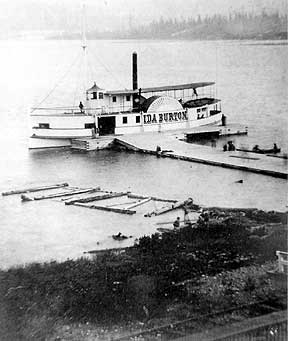|
 The
Ida Burton: The
Ida Burton:
Pride of Lake Simcoe
by Andrew Hind
It was not a romantic ending fate
dealt this elegant, historic vessel—the last side-wheeler
to ply its trade on the waters of Lake Simcoe.
The attractive wooden ship with large
paddle wheels midway from stern to bow, was built in an era
when steamship travel was nearing its end. But not only did
the Ida Burton go on to become one of the most successful
steamships of the day, the side-wheeler was the only one ever
built in Barrie harbour. Steamships were relatively easy to
build and did not require special dry-docks or slips, so communities
all around the lake—some, little more than villages—built
them.
Not a lot of facts are known about the
physical dimensions of this paddle ship, but the length was
between 100-110 feet—longer than 75-foot sister ship
Carrie Ella and much smaller than the 144-foot Emily May.
Sleek lines gave the Ida Burton a graceful appearance as it
cut through the water, but it was also a very sturdy craft
capable of sustained steaming at speeds averaging 12-15 miles
per hour.
In the mid-1800s waterways were the nation’s
highways until railways and roads spread across central Ontario.
Travel was economical, quick and relatively comfortable aboard
steamships crisscrossing Lake Simcoe ferrying mail, freight
and settlers to outlying settlements. They were vital to the
survival and growth of towns supplying farm goods and lumber
to railheads destined for distant markets. More than utilitarian,
they provided an element of romance to an otherwise difficult
era.
The pride of the Lake Simcoe fleet was
named after Ida, the beloved mother of Burton brothers James
Lindsay (1848 to 1910) and Martin (1852 to 1914). The two
men were among the most prominent businessmen in 19th century
Barrie. Together they had a hand in most of the large industries
in town and owned nearly half of the nearby Village of Allandale
(now engulfed by Barrie). James Lindsay (J.L.) occupied most
of his time with the Northern Navigation Company, whose fleet
steamed across the waters of Georgian Bay, Lake Simcoe, and
Lake Couchiching, delivering mail, cargo, and passengers.
Because Barrie wasn’t a major port,
or even a particularly notable community until mid-century,
the Ida Burton was the only side-wheeler the Burton’s,
or anyone else, ever built there. Trains had cornered the
shipping market by the time the rails reached Barrie in the
early 1850s. The town lost its reliance on water transportation,
but other communities not directly reached by rail continued
to build ships.
For nearly a decade, from 1866 to 1875,
the Ida Burton left Barrie harbour with train travelers from
Toronto bound for luxury hotels on the Muskoka Lakes. First
stop Orillia, then full speed ahead across the length of Lake
Couchiching for connections with Northern Railway. From this
railhead at Washago, on the Severn River, weary travelers
once again rode the rails until Gravenhurst where they boarded
a final steamer.
The Ida Burton was hired for private functions
at a time when the temperance movement was making headway
in reducing alcohol sales in Ontario. Consuming alcohol was
often frowned upon, especially among the well-heeled, “upstanding”
citizens. Private excursions aboard the Ida Burton were rarely
dry, used instead as opportunities to indulge in alcohol away
from prying eyes. Parties, complete with musical entertainment,
were often the highlight of the summer social season—along
with the occasional cancelled wedding.
One day a strapping lad by the name of
Jimmie Reid was about to marry, the ceremony mere hours away.
Everyone was decked out in their finest, eagerly anticipating
the nuptials. Suddenly, a gasping friend raced up to the anxious
groom. The wedding had to be called off! The bride, Nora McGlashen,
was Irish on her mother’s side! Scotsman Jimmy Reid agreed;
union with an Irish lassie was completely unacceptable. He
broke the news to the assembled guests. There would be no
wedding today! All dressed up with nowhere to go, many of
the guests—and reputedly the groom as well—decided
to have a party anyway. By all accounts, it was a raucous
affair aboard the Ida Burton where whiskey and good times
flowed. Not so amused were fellow passengers, the Sons of
Temperance, advocates for abstinence from drink.
Such heady days could not last forever.
Roads improved and railways snaked north. Operators tried
to make a living offering luxury cruises to tourists, but
competition was fierce. The final blow was dealt from a new
source—the Muskokas. As the area opened, it catapulted
up the list of vacation spots in Ontario and conversely, steamers
disappeared one-by-one from Lake Simcoe.
In less than two decades after the launch
of the Ida Burton, railways had stretched their web from Toronto
to Gravenhurst. Steamships and similar vessels were left to
rust. With its primary income gone it was only a matter of
time before the Ida Burton went to a watery grave alongside
so many kin.
The inevitable came in 1876 when the ship,
stripped of machinery, was unceremoniously sunk along the
Orillia shoreline. Though the once elegant side-wheeler ended
up as foundation for a wharf, it will always be known as the
Pride of the Lake Simcoe fleet.
The steamship’s passing was little
more than a minor setback for the Burton brothers who went
on to help found the Barrie Electric Light Company. Martin
also went into the lumber business in a big way. With extensive
timber rights and a huge mill at Byng Inlet along Georgian
Bay, he became one of the wealthiest lumber barons in Ontario.
J.L. devoted much of his later years to local politics, spending
many years as deputy reeve of Barrie and reeve from 1889 to
1890.
This is an original story,
first published in The Country Connection Magazine,
Issue 45, Spring 2004. Copyright Andrew Hind.
RETURN
TO STORY INDEX
RETURN
TO BACK ISSUE PAGE
|

